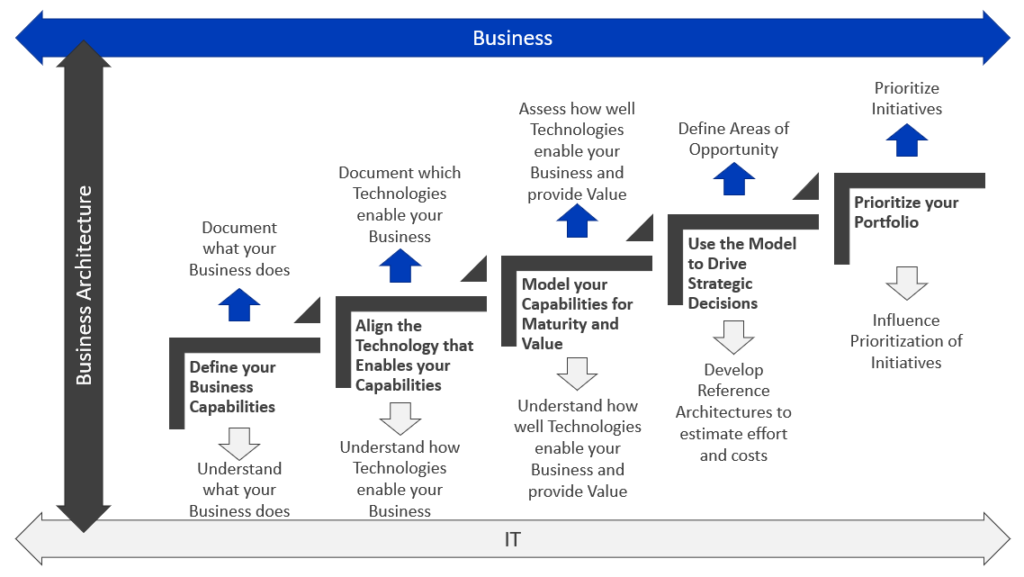The Fractured Relationship
In the modern business landscape, the relationship between Information Technology (IT) and the broader business functions is pivotal for success. Often, IT and the Business have different perspectives, priorities, and expectations, leading to miscommunication, frustration, and inefficiency. Some of the root causes of this conflict are:
- Lack of a shared vision and understanding of the organization’s purpose, value proposition, and capabilities.
- Different languages, terminologies, and metrics used by IT and the Business.
- Conflicting or unclear roles and responsibilities.
- Siloed thinking and decision-making.
- Misalignment of resources, investments, and incentives.
Amidst the fractures, there exists a powerful tool that can mend these divides and foster collaboration: Business Architecture.
Why use Business Architecture?
The rift between IT and the Business is not a new phenomenon. Historically, IT departments have been perceived as enigmatic entities, speaking a language unintelligible to the rest of the organization. Meanwhile, business units have been accused of being disconnected from the technological capabilities that could drive their strategies forward. This discord often results in costly delays, failed projects, and missed opportunities.
Enter Business Architecture—a discipline that helps organizations design, plan, and govern their business transformation initiatives. It provides a holistic and integrated view of the organization’s strategy, goals, capabilities, value streams, information, and stakeholders. By using a Business Architecture Framework, IT and the Business can:
- Establish a common language and framework to communicate and collaborate.
- Identify and prioritize the most critical and valuable business outcomes and capabilities.
- Define and map the end-to-end value streams and processes that deliver value to customers and stakeholders.
- Align IT solutions and services with the business needs and requirements.
- Measure and monitor the performance and value of IT and the Business.
This leads to:
- Building trust and mutual respect.
- Sharing a common understanding of the organization’s value proposition and capabilities.
- Co-creating and co-delivering solutions that meet customer expectations and needs.
- Leveraging each other’s strengths and expertise.
- Optimizing the use of resources and investments.
- Minimized risk of investing in projects that do not deliver tangible value.
Business Architecture encourages transparency and accountability across the organization. By documenting and visualizing the interdependencies between business processes, data, applications, and technology infrastructure, Business Architecture enables stakeholders to identify bottlenecks, inefficiencies, and areas for improvement. This shared understanding fosters a culture of collaboration, where IT and business teams work together to streamline operations, optimize resources, and drive innovation.
Business Architecture also provides a roadmap for strategic decision-making and investment prioritization. By mapping out the current state of the organization’s business capabilities and identifying gaps and opportunities, Business Architecture empowers leaders to make informed decisions about where to allocate resources and investments. This strategic clarity enables organizations to focus on initiatives that deliver the greatest value and competitive advantage.
Additionally, Business Architecture serves as a catalyst for change management and organizational transformation. By providing a comprehensive view of how changes in one part of the organization impact others, Business Architecture helps mitigate the risks associated with complex transformation initiatives. IT and business stakeholders can anticipate potential challenges, proactively address resistance to change, and ensure smooth transitions to new processes, systems, and technologies.
The Exec Architecture Map
One key requirement of Business Architecture is that it MUST be supported at the C-Suite level. Top-down direction will ensure support of strategic initiatives and force alignment across the organization. It creates a line of two-way communication from the Executive team to functional leaders which provides the transparency and accountability necessary to execute effectively. I have developed a tool, The Exec Architecture Map, that helps to communicate the strategic direction at a high level which can be used to inform across the organization. It is meant to be a point-in-time view of the current strategic initiatives. The components included are:
- Business Capabilities – shows the business capabilities that are being impacted.
- KPI’s – shows the performance measurements that are in focus.
- Technology – shows how the technology landscape will change.
- Organization – shows changes to the functional teams.
- Culture – shows the areas of focus for culture improvements.
- Process – shows the key processes that are being impacted.
The map enables Executives to ensure that the strategic initiatives in focus are aligned with their priorities.

Conclusion
Business Architecture offers a powerful framework for repairing the fractured relationship between IT and the Business. By fostering collaboration, alignment, transparency, and strategic clarity, Business Architecture enables organizations to harness the full potential of technology to drive innovation, growth, and competitive advantage. In an era defined by rapid digital transformation and evolving business dynamics, Business Architecture serves as a linchpin for building resilient, agile, and future-ready organizations. As businesses navigate the complexities of the digital age, investing in Business Architecture is not just a strategic imperative—it’s a pathway to sustained success.

